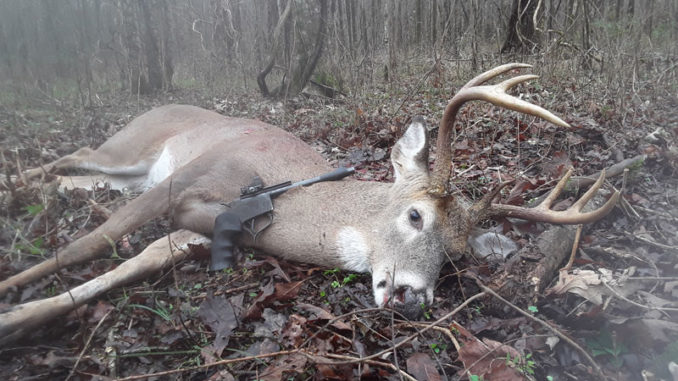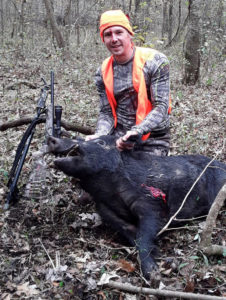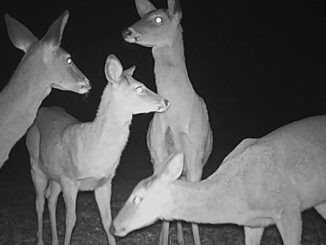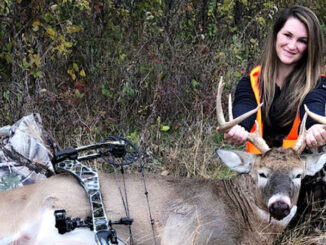
Scout locations now so you’ll know where deer are bedding down next season
In the Mississippi River bottomland hardwoods, I find newly fallen treetops are the most attractive places for deer to hide on pressured public lands. The dead leaves and branches make the deer nearly invisible, while leaving everything approaching out in the wide open for the bedded buck to see.
Many years ago on an archery stalk, I jumped two smaller bucks from a treetop. As I snuck closer to inspect the beds, a very nice buck slipped out and made a break for it. My 25-yard shot hit a limb instead of the deer, but my fascination with fallen treetop hunting started that day.
After jumping that same deer several times all season, I finally shot that 16-inch inside spread buck during gun season while chasing a doe just 200 yards from that treetop.
A few years later, I jumped a nice 9-pointer from a treetop on the way into the woods. I hooked around and within an hour, I downed that double white-patched beauty with my muzzleloader.
As I started to hone in on fallen treetops or large branches within the past few years, my deer sightings increased. The newer fallen limbs with leaves seem to be favorites, so each year I’m on the hunt for these rare gems.
Sure, I jump deer from other areas like small thickets patches or high stumps in flooded areas. But the overall theme still remains the same – they’re all thick hiding spots with nice open views of anything approaching.
Often deer bed on the downwind side of a larger treetop. This leaves anything approaching out of view upwind where the deer can smell it. And the buck is able to see anything approaching from downwind where it doesn’t have the help of its nose.
Learning treetop locations also are valuable when it comes to tracking. Oftentimes a wounded animal will bed up in thick fallen limbs. Knowing these locations can help find a lost animal, or allow for a stealthy approach to look into the brush pile. Once I tracked my brother’s buck several hundred yards. Hours later, I finally finished off the wounded deer when I saw it hiding in a blown over tree.
Well, this year’s destructive November storm system brought a fury of wind and some tornados across the South — so I couldn’t wait to get into the woods and find new trees that had fallen over.
To my shock, a tornado ripped through one area, leaving more than 75 percent of all the large trees snapped in half like toothpicks. This was wonderful — except it gave me too many trees to target. I have the most action in areas with just several downed trees to focus on.
On either-sex gun days, as I stalked some brush piles, something large shook the branches. I readied my micro .35 Remington Contender on the monopod and a huge boar stood up. However, I had to twist and half squat to line up in the brush. I drilled the big pig — but the gun drilled me back. With blood gushing, I cleaned my pig and backpacked it out.
After several December archery hunts, it was time for bucks-only gun days. The bucks’ nocturnal habits began to cease as the rut approached, and I had jumped bucks practically every trip in the woods from treetops in an area.
I studied the terrain carefully, taking into account where I was seeing does and thick travel lanes with popular intersections. The deer may go in the open woods to feed at night, but they mainly stick to moving in thick sapling and briar ridges during daylight. Bucks often move along those ridges into a crosswind.

Also, I jumped many hogs from treetops as well, but started passing on dozens of shots offered because my freezers were full of wild pork.
I had already killed one buck and was looking for a nice one with my pistol. I had to set up similar to a bow hunt to achieve my handgun goal. I found several big treetops on a north – south running sapling ridge, with the perfect tree to climb, but I needed a west wind.
After the onslaught of rain in the first week of January, that perfect west wind would blow for me. I stalked nonstop in the rain for two days without any luck. Then, the evening before my hunt, I drove out to make sure my road wasn’t flooded and everything looked good.
Well, the morning didn’t go as planned. I woke up to a dead battery in my truck, and I was alone at the camp for my hunting vacation. However, I had recently bought a new jump-starter. Without ever using it before, I connected it and crossed my fingers as I turned the key – thankfully, it started.
Disaster was averted until I got a couple miles away from where I planned to park. The water rose overnight, and was gushing over the road — nearly to my knees. Some trucks had gone through, but there was no way was I chancing getting stuck back there.
So I began my two-hour hike through mostly shin-high flooded woods to make it to the tree I had picked out within a fallen treetop. Finally, at 7 a.m., I get there and began to slowly climb. As I’m climbing up, one of the dead limbs catches my climber and made a noise: A big deer got up and left.
Before long I saw another deer pass by. Then, I was just hearing birds and squirrels making noise in the dead branches underneath me. Unexpectedly, I caught a glimpse of a rack walking right to me: It was a really nice 7-pointer I had jumped the previous week.
Apparently, I had picked the perfect fallen treetop because the deer walked directly into the one I was set-up in. It eased into the thick tangle of dead limbs and stopped broadside just 12 yards away to work a lick branch.
I started my camera and grabbed the .44 mag Contender pistol. But my pistol’s trigger guard got hung up on my bag. Buck fever had me shaking, but I got my composure and freed the weapon without much movement. However, I didn’t want to move much to set up the monopod that was between my knees.
I lined up the freehanded shot to my side. With a strong grasp to avoid jerking low, I squeezed off a round. The struck buck ran underneath me and disappeared into the saplings as I reached for another round for the crack-barrel handgun.
Seconds later I saw the deer drop and make a few final kicks 50 yards away in the thickness of the sapling ridge, and the celebration began.
I hustled out of the woods to get my backpacking gear for the task of getting my meat out of the forest. A couple of ATV riders offered assistance, but I politely declined. The hard six hours of work to clean, quarter and backpack out my 100-plus-pounds of bone and meat was part of the experience I love just as much as the harvest.
It was a truly memorable day in the woods, and I spent the rest of the evening processing and freezing all of the meat then getting my skull ready for a self-made European mount.
The next day I was back in the woods looking to till my final buck tag. I went on a “shake, rattle and roll” stalk mission with my rattling sheds among the fallen treetops, which I’ll detail in a future article. I had a nice racked buck run right up to me from out of a large downed tree. I wasn’t able to line up a shot, but keying in on the deer’s natural ground blinds had produced two tantalizing experiences in back-to-back days that I’ll never forget.
Even though deer season is closed, now is a great time to hit the woods searching for treetops to hunt next year. And bring in legal ammo during small game season and down some pork while you’re discovering where those pressured late-season bucks go to take their naps.


